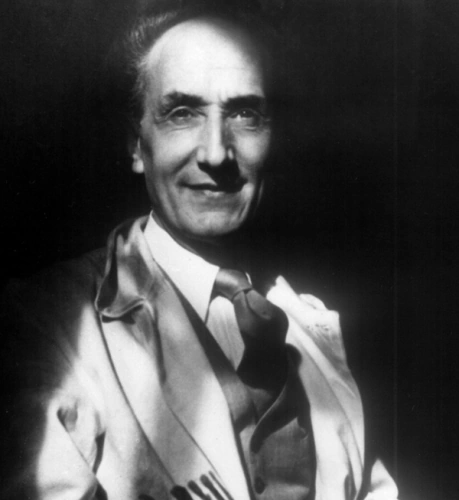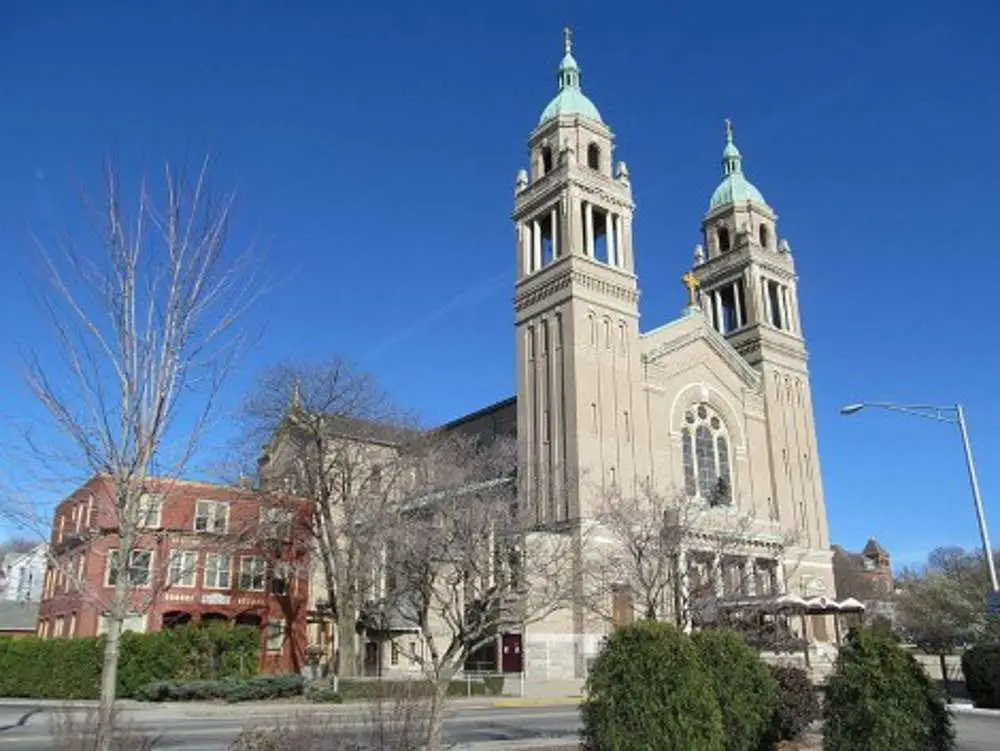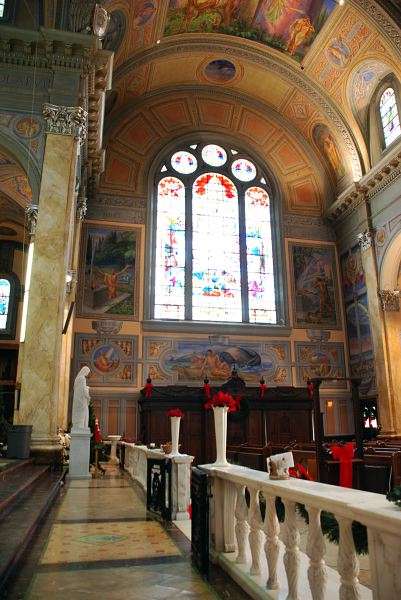St. Ann Roman Catholic Church in Woonsocket, R.I., was built from nickels and dimes donated by poor French-Canadian millworkers and their families after the turn of the 20th century. During the 1940s, one of the Catholic Church’s greatest artists painted 475 images of St. Ann’s parishioners — including 40 angels — into frescoes on the building’s walls and ceiling.
Mischievous boys appeared as devils, soldiers and sailors depicted the horrors of war and the nun who played the church organ was transformed into St. Cecilia. A modest bank teller was immortalized as 40 angels representing virtues such as faith, hope and charity.
The church, now a cultural center, is sometimes called the ‘Sistine Chapel of America.’ With seating for 1,500 people, St. Ann is big enough that the Sistine Chapel could fit into it. The similarity lies in the frescoes, which an Italian artist created using Michelangelo’s technique, a rarity in North America.
Woonsocket
In 1900, Woonsocket was 60 percent French-Canadian, one of the most French cities in America. The French were Quebecois farmers who came to work in the Woonsocket textile mills and factories. They resisted assimilation into America and kept their French identity by recreating the social, religious and commercial institutions of Quebec.
St. Ann parish, founded in 1890, was located in the once-flourishing le Coin de Social, or ‘Social Corner,’ neighborhood of Woonsocket. The church complex included a gym to encourage young people to stay within the community and a theater that featured popular French language plays.
In 1914, the diocese assigned a French-speaking Belgian priest to the parish. The St. Ann parishioners, unhappy that he wasn’t French-Canadian, gathered in a snowstorm to bar him from saying Mass. The diocese caved to their wishes and replaced him with a French-Canadian priest.
That same year the parish laid the cornerstone for a new church building. For 30 years Mass had been held in the basement of another church or in the school. St. Ann parish raised $150,000 for the ambitious building project from its working-class parishioners. Some of them earned $7 a week and donated a dollar of that to the Sunday collection.
Plain Glass Windows
The cathedral-like church, designed by French-Canadian architect Walter Fontaine, first opened its doors in 1918. The parish didn’t have enough money, though, to decorate it. It had windows of plain glass and walls of gray stucco.
Over time, St. Ann raised the funds for stained-glass windows. In 1930, the church installed 40 windows created by the same company that made the windows for the Chartres Cathedral in France.
The church flourished during the 1930s. With 6,000 parishioners, seven Masses were said on Sunday. The Rev. Ernest Morin led the drive to raise $25,000 to add more color and decorate the church’s gray interior walls.
Father Morin then hired an Italian-Canadian artist, Guido Nincheri, to spend two years painting pictures showing why St. Ann was the greatest saint.
Nincheri had a better idea. From 1941 to 1953, he worked on 175 glorious frescoes in the style of Michelangelo.
Guido Nincheri
Guido Nincheri was born in 1885 in Italy, the son of a wealthy textile broker. He studied at the Academy of Fine Arts in Florence. Then he emigrated to Montreal when World War I broke out and made a name decorating French-Canadian Roman Catholic churches.

Guido Nincheri
Nincheri, a tiny, devout hunchback, was knighted by Pope Pius XI in 1933 as one of the great artists of the Catholic Church. But in Montreal during World War II he got into trouble for including an image of Benito Mussolini in a fresco at the Church of the Madonna della Difesa. The Royal Canadian Mounted Police arrested him in 1940 as a fascist and sent him to an internment camp for three months. His wife Giulia got him freed by showing authorities his early sketches, which proved church trustees forced him to include the dictator.
After that Nincheri preferred to work in Rhode Island.
40 Angels
When Father Morin first took him inside St. Ann, Nincheri was thrilled to see the bare stucco walls. He realized he could, for the first time in North America, use the technique of painting into damp plaster that Michelangelo used on the Sistine Chapel.
Nincheri knew of the sacrifices the parishioners had made to decorate their church. He rewarded them by painting them as 40 angels on the walls.
Nincheri paid children 50 cents and a peanut butter sandwich to model. He asked a nun who taught 7th grade at St. Ann to send him the two most mischievous boys to portray the devils in the Last Judgment scene. Nincheri’s wife Giulia is St. Ann. The nun who played the church organ is immortalized as St. Cecilia, patron saint of music.
Marguerite Forget
Marguerite Forget worked as a teller at Woonsocket Trust and sometimes sang solos with the St. Ann choir. One day Father Morin brought a small hunchbacked man into the bank and introduced them.
Nincheri asked her to pose for him.
Forget refused, thinking it improper. Nincheri never asked again. But he did come to visit her and her parents in their home on Elm Street and chat with them in French. Every night he would abruptly say, “I’ve got to go.” Then he would stand up and run back to his apartment on Wood Street nearby.
Forget and her mother came up with an explanation for his odd behavior. They thought he felt the urge to exercise because he sat on a stool all day in the same position.
One day Forget was in the church practicing on the church organ and Nincheri approached her. He had finished his frescoes of 40 angels.
Frescoes
“What do you think of yourself?” he asked her. Marguerite then looked up and saw her face on 40 angels in frescoed medallions on the side aisle ceilings.
During those evening conversations on Elm Street, he had studied her face, then raced home to sketch her before the image faded from his mind. Nincheri explained later that he chose her as a model because he liked the look in her eyes.
Nincheri didn’t just paint 40 angels. He knew many families had lost sons in combat during World War II, and he acknowledged their loss in two medallions. He painted graphic scenes of drowning sailors and of a soldier shot in the back.
Nincheri also painted a Garden of Eden scene with a nude Adam and Eve. Parishioners complained, and in 1953, he covered them partially with leaves. Then he took down his scaffolding and told the parishioners if they wanted more leaves, they’d have to paint them themselves.
Rebirth of the 40 Angels
Over the years, St. Ann went into decline, and the Diocese of Providence closed it in 2000. Former parishioners and art lovers then formed a nonprofit and worked to save the building. They created the St. Ann Arts and Cultural Center and work to preserve and maintain it. Visitors can see the 40 angels on tours, and the Center offers cultural programs.
The Italian government knighted Nincheri in 1972, the year before he died. In addition to the 40 angels of St. Ann, his frescoes and stained glass windows appear in nearly 100 churches in Canada and a dozen in Rhode Island.
Three of his largest works are in the Church of Christ the King, in West Warwick, R.I. His work can also be seen at the Roger Williams Park Museum of Natural History and Planetarium in Providence.
Pope Pius XI dubbed Nincheri ‘the church’s greatest artist of religious themes’.
With thanks to Hidden Beauty by Elizabeth Gudrais for the Providence Journal. Exterior image of St. Ann by By John Phelan – Own work, CC BY-SA 3.0, https://commons.wikimedia.org/w/index.php?curid=18819427. This story about the 40 angels of St. Ann was updated in 2023.



7 comments
It is often said that “one’s ‘trash’ is another’s Treasure” and this warm, touching and absorbing happening has become a source of most refreshing hope and happiness to this ‘homebound’ 83 year old veteran of Korean War…… sooo, sooo long ago! It is so very hard to believe that this REAL TREASURE was not seen as such for its’ potential when that Roman Catholic Diocese perceived compelling need to abandon it as ‘TRASH’!!!???, and by supposedly the self-proclaimed as ‘Society’s Preserver Of Civilizations Great Art & Culture over the past thousands of years”! Thank goodness that Diocese is not the Guardian of Vatican Art Treasures and the Sistine Chapel !! This precious story so compellingly commands us to appreciate the Great purpose and Function of the N. E. Historical Society and it irreplaceable value to and for each one of us. THANK YOU EACH & ALL of the SOCIETY.
[…] Healy was an unusual man who harbored ambitions for his children. Three became nuns, three became priests and one had a successful career in the Revenue Cutter Service. James and his brother Patrick rose to positions of great influence within the Roman Catholic Church in America. […]
[…] was raised in Westbrook, where his father worked as a pharmacist. He grew up with a mix of French Canadian-Irish good looks, and took up the drums and later the saxophone. After an aborted attempt to enlist […]
[…] and started the first credit union in the United States, also named St. Mary’s, in Manchester. St. Ann Roman Catholic Church was built with nickels and dimes from French Canadian millworkers and painted with such magnificent […]
[…] St. Ann Roman Catholic Church in Woonsocket, R.I., was built from donations by poor French-Canadian millworkers . https://newenglandhistoricalsociety.com/the-40-angels-of-st-ann-the-sistine-chapel-of-woonsocket/ […]
Guido Nincheri started in stained glass arts under the wing of Henri Perdriau of Montreal. Perdriau joined in 1925 the Sentinellistes, a Franco-American defense movement which caused some agitation in New England. St. Ann Church was the birthplace of the movement.
Nincheri may not have produced stained glass windows for St. Ann but he delivered over 5000 windows in 200 churches in North America.
Thank you for the article, I hope to go there one day.
[…] Roman Catholic parish was central to life in New England’s Little Canadas, and New Year’s Mass was central to the […]
Comments are closed.